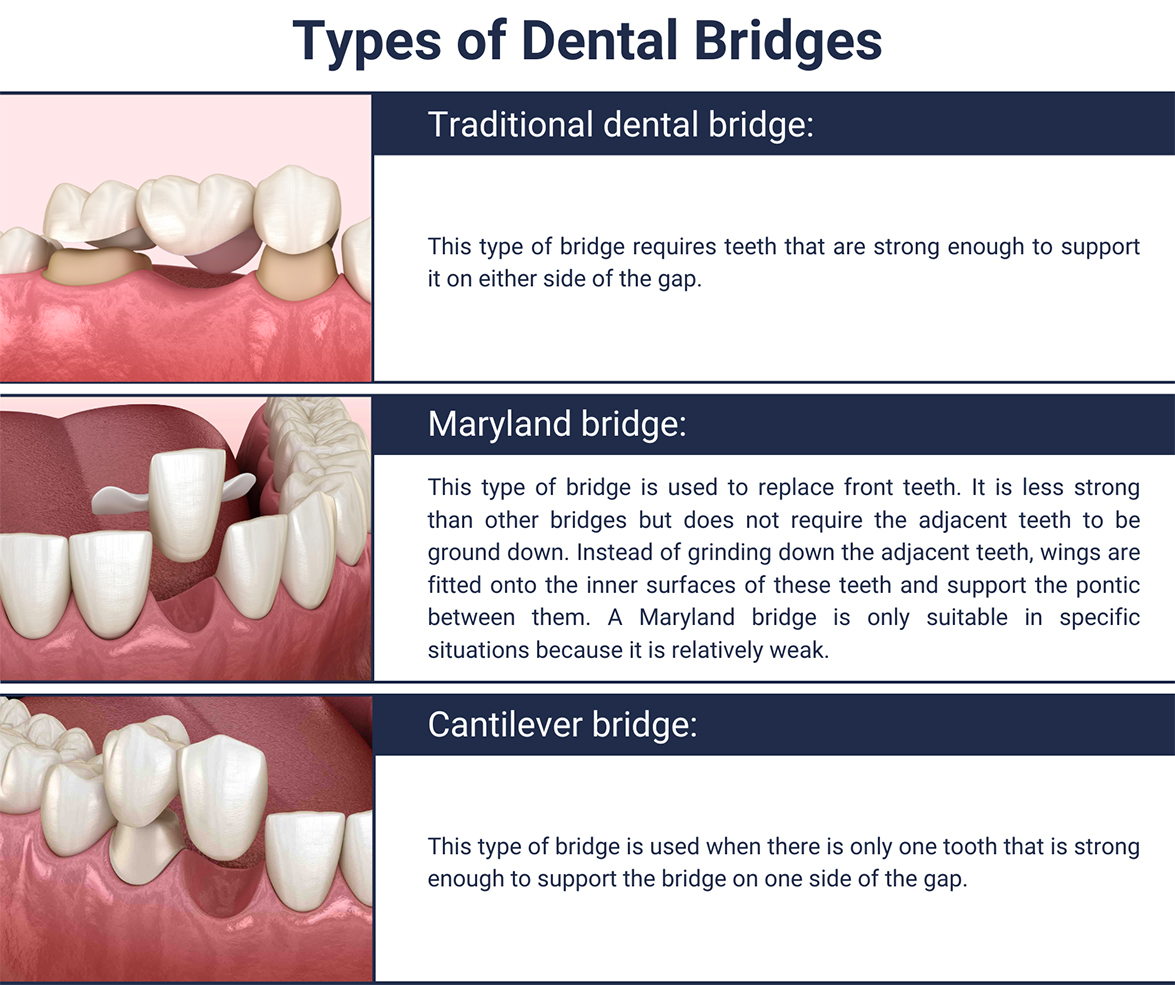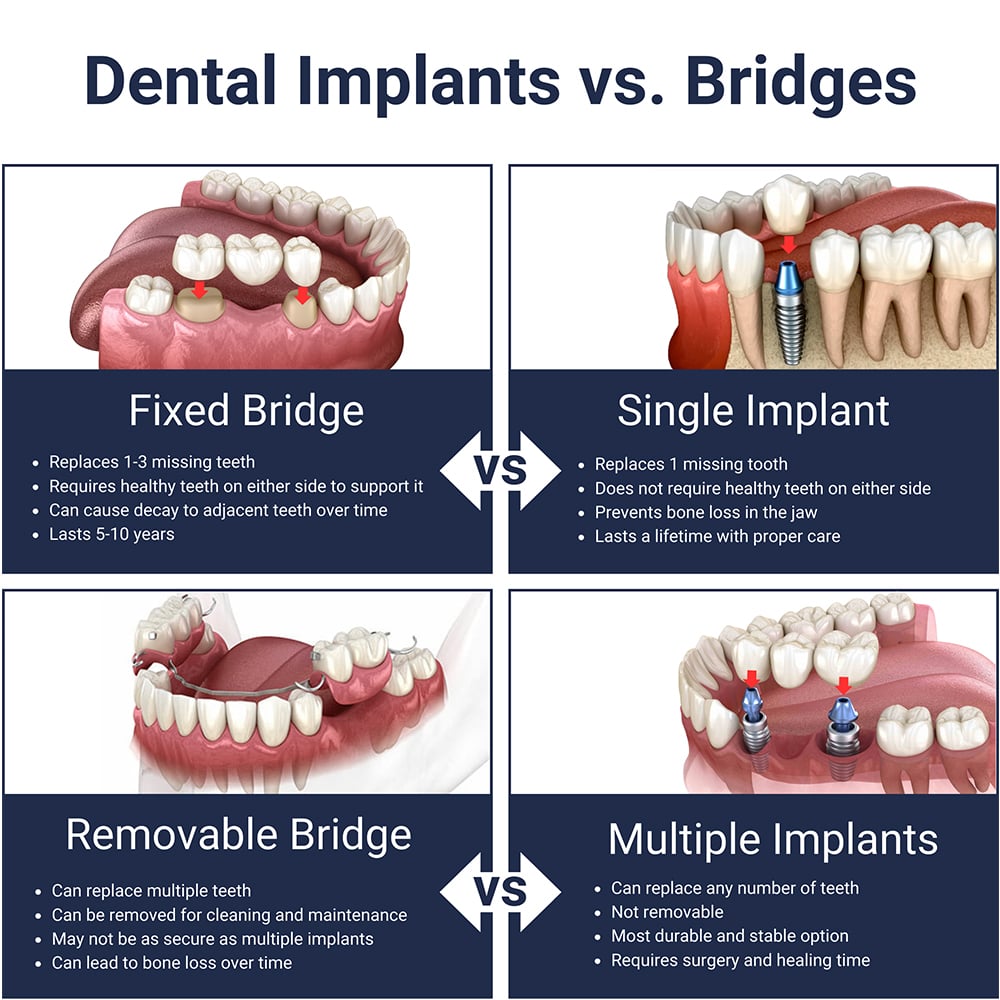Table of contents
It’s easy to underestimate the impact of losing teeth until it happens to you. Then you discover exactly why a full set of teeth is so important. Even the loss of a single tooth can affect your dental health and can seriously impact your self-confidence when tooth loss is right in your smile line. Replacing missing teeth as soon as possible is important. The two most common solutions are dental implants and dental bridges.
Both options will fill in the gap left by missing teeth but are technically quite different. Therefore, it is vital to understand how each works, whether it is suitable for your requirements, and what is involved with each treatment.
What is a Dental Implant?
 The simplest way to imagine a dental implant is as an artificial tooth root. It has a post or screw made from either titanium alloy or zirconia, a strong ceramic material, that is surgically inserted into your jawbone. Once in the jaw, a second component called an abutment is fastened onto the screw and protrudes above the gum line. The abutment supports a replacement tooth.
The simplest way to imagine a dental implant is as an artificial tooth root. It has a post or screw made from either titanium alloy or zirconia, a strong ceramic material, that is surgically inserted into your jawbone. Once in the jaw, a second component called an abutment is fastened onto the screw and protrudes above the gum line. The abutment supports a replacement tooth.
While single tooth implant can support a single implant crown, you can have two or more dental implants placed to support a dental bridge, provided the missing teeth were all originally next to each other.
If you have a complete arch of teeth missing, only six or even four dental implants can hold either a dental implant bridge that is fixed firmly onto the implants and is non-removable or an implant denture. The implant denture is removable but clips firmly onto the implants so it cannot move while in the mouth.
Pros and Cons of Having Dental Implants
Pros of dental implants
- Protect remaining teeth: Dental implants help protect any remaining teeth, reducing the burden placed on these teeth when you bite and chew food and preventing teeth from moving out of position.
- Protect jawbone: Dental implants help protect your jawbone because the implant posts act as artificial tooth roots. These artificial tooth roots closely replicate real tooth roots, helping to stimulate the bone surrounding them and preventing bone resorption that occurs naturally after tooth loss. It’s an extremely important advantage because bone loss can affect the stability of remaining teeth and changes the overall dimensions of your face, so it can begin to have a collapsed in appearance.
- No need to reshape adjacent teeth: Unlike a dental bridge, there is no need for an implant dentist to reshape the teeth adjacent to the gap. When you have a dental bridge, the adjacent teeth must be ground down and covered with dental crowns that support the replacement teeth.
- Long-term solution for tooth loss: Dental implants can be a long-term solution for tooth loss, provided they are cared for properly.
Cons of dental implants
- High initial cost: The main downside of dental implant treatment is the initial cost, especially if you need several teeth replaced or require additional treatments like bone grafting. The costs can increase if you lost teeth some time ago or have suffered tooth loss due to periodontal disease resulting in the deterioration of your jawbone.
- Surgery involved: Dental implant treatment requires surgery to place the implant posts in the jawbone.
- Requires multiple trips to the dentist: Dental implant treatment takes longer to complete and can require multiple trips to your implant dentist.
- May take several months to complete: Treatment may take three to six months or even longer if additional procedures are needed in preparation for implant surgery. In comparison, a dental bridge can be completed within a matter of a few weeks.
What Is a Dental Bridge?

A dental bridge is a tooth-supported appliance used to replace missing teeth. It consists of crowns fitted over the teeth adjacent to the gap, which support the replacement teeth (pontics).
There are three main types of dental bridges:
- Traditional dental bridge: This type of bridge requires teeth that are strong enough to support it on either side of the gap.
- Cantilever bridge: This type of bridge is used when there is only one tooth that is strong enough to support the bridge on one side of the gap.
- Maryland bridge: This type of bridge is used to replace front teeth. It is less strong than other bridges but does not require the adjacent teeth to be ground down. Instead of grinding down the adjacent teeth, wings are fitted onto the inner surfaces of these teeth and support the pontic between them. A Maryland bridge is only suitable in specific situations because it is relatively weak.
To fit a dental bridge, a dentist must substantially reshape these adjacent teeth to ensure the crowns fit properly and don’t look and feel too big, bulky, or unnatural. This can weaken the teeth and make them more susceptible to infection and decay.

Pros and Cons of Choosing a Dental Bridge
Pros of Dental Bridge
- Speed of treatment: Dental bridges can be made and fitted within a few weeks.
- Cost-effectiveness: Dental bridges are a relatively cost-effective treatment option.
- Minimal invasiveness: Dental bridges are a minimally invasive procedure, meaning that only a small amount of tooth structure is removed.
Cons of dental bridge
- Effect on existing teeth: The biggest disadvantage of choosing a dental bridge is the effect on your existing teeth. As mentioned earlier, the teeth adjacent to the gap must be substantially reshaped and ground down to create enough room for the dental crowns to fit comfortably and to feel natural and not too bulky. If these teeth are healthy, strong, and nicely shaped, grinding them down can be undesirable.
- Additional strain on abutment teeth: There is also the problem of additional strain on these abutment teeth, as they have to absorb the stresses and strains created when you bite and chew food on the replacement or pontic teeth as well as on your natural teeth that have been crowned.
- Risk of infection and decay in the future: Removing any tooth structure from teeth leaves them at greater risk of infection and decay in the future, especially as restorations like crowns start to age and potentially leak, letting in decay-causing bacteria.
- Bone resorption: A dental bridge doesn’t address the problem of bone resorption. As a result, it is possible that a gap may develop underneath the pontic as the jawbone gradually continues to resorb.
Additional disadvantages of cantilever and Maryland bridges
- Cantilever bridges: Cantilever bridges are particularly bad for placing stresses on teeth, especially when a single tooth is used for support.
- Maryland bridges: Maryland bridges can also cause problems and are more liable to become dislodged as they have limited capacity to absorb any strain or stress.
It is important to weigh the pros and cons of dental bridges carefully before deciding whether or not this is the right treatment option for you.
Deciding on the Best Solution
When you see your dentist for tooth loss, they can examine your existing teeth and assess your oral health and general health before discussing the most suitable solution for your tooth loss. This may depend on whether you have existing teeth that are healthy and strong enough to support a dental bridge and also on your finances.
While dental implants are generally more expensive initially, it’s worth remembering they can be more cost-effective in the longer term. Replacing a single tooth with a single dental implant crown will ultimately prove more cost-effective when replacing the restoration. Otherwise, you would need a new three-tooth or three-unit bridge; when the time comes to replace it, it will cost more than a single implant crown. That is without considering the effect on the adjacent teeth and your jawbone.
Dental implants vs. dental bridges: Insurance coverage and payment options
A good dental insurance policy will most likely cover most or all of the cost of a dental bridge, but it’s less certain when it comes to dental implants.
Dental bridges
- Most dental insurance policies cover most or all of the cost of a dental bridge.
Dental implants
- Dental implants are a more expensive treatment option, but they may be more cost-effective in the long term.
- More insurance companies are regarding dental implants as a necessary treatment and may cover some of the costs.
- Contact your insurance company to determine what they will cover before making your final decision.
However, if you have your heart set on dental implants and you don’t have insurance, or it won’t cover the costs, ask your dentist if they have any easy payment schemes. Many dentists, including Dr. Rahmani will allow you to spread the cost of treatment over months or years with low-interest repayment schemes or zero-interest repayment plans.

If you have any questions about the difference between Dental Implants and Bridges or would like to schedule an appointment with the best-rated implant dentist, Dr. Rahmani of NYC Dental Implants Center, please get in touch with our office for a consultation.
NYC Dental Implants Center
121 East 60th St Ste 6C2
New York, New York 10065
(60th St. btw Park Ave / Lex Ave)
☎ 212-256-0000
Consultation
